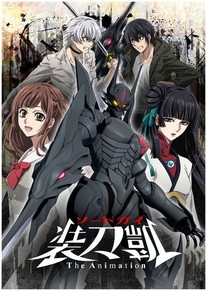Review
by Theron Martin,Sword Gai: The Animation Part II
| Synopsis: |  |
||
The battle with Zsoltgewinn ends calamitously, with Ichijo turning into a Busoma and Gai being forced to fulfill a promise that has serious consequences for him. Meanwhile, other threats are afoot as Marcus loses control over a matter of love, Kagami schemes to rescue her father even at the cost of crossing the Shoshidai, Shin starts to take an interest in Sayaka, Shin's sister endures her own perils, and Princess Himiko starts making moves of her own. A bullied youth also gets help from an unlikely source, while a certain hairdresser just can't seem to shake the attentions of a certain portly hammer-wielder. Behind it all, a couple of key schemers, one human and one Busoma, make their ultimate moves. |
|||
| Review: | |||
In some respects, the second half of this manga adaptation is a significant improvement over the first, in large part because it corrects one of the major flaws of the first half. In other respects, however, it not only continues the problems presented by the first half but even exacerbates them, resulting in a conclusion that's slightly better than its start, but still hardly good. The biggest improvement comes in this second season's improved cohesiveness. The widely-scattered plotlines are now converging as characters who mostly acted independently before are now interacting, which gives a clearer sense of an overarching story that was only vaguely present before. No one who actually survived the first half has been forgotten (even if one or two of them don't last long), and there are some mild surprises in the final destinations of certain characters who survive the second half. The survivors in question aren't terribly hard to predict with a few exceptions, and of the couples that form by the end, one of them is actually rather sweet, while another is the end result of a running gag. The problem is that the increase in cohesiveness doesn't correct any of the series' other flaws. Gai is not a single iota more appealing or sympathetic as the titular protagonist, whether in human form or after becoming a Busoma for a while. In fact, the story generally works better during the scenes where that huge killjoy isn't around. Making a brooding hero is all fine and good, but there still has to be at least some other hook to his personality for us to care about him. And don't even get me started on the doctor/scientist who takes kids out to the amusement park to offset the fact that he's doing torturous experiments on them. Throw another “surprise” antagonist in the mix and there's definitely no shortage of scummy opponents for Gai to face, even without good guys turning into bad guys. At least the series has some decent secondary characters, such as the kid who makes the pact with the Iron Maiden. Story flow is another problem. The story still has sudden jumps that make you feel like some connecting scenes were deleted, with story turns that stretch credibility in many places. The Shoshidai's long game for planning to deal with the Busoma is also difficult to parse, and then there are the random super-Busoma who show up to guide the two aspects of the shiryu into a godlike being to further humanity's destruction or some such thing. Where those came from or how they came to be is never explained, nor are the strangely merciful actions of the one who survives at the end. At least we do get some hyper-violent deaths for some of the more embarrassingly incompetent major cast members. At least the technical side of the production is still decent. Busoma continue to get the full CG treatment, but it's not bad and some of the fight scenes actually deliver some appealing action. The effectiveness of the color scheme to convey the mood in various scenes is still a strong point, and both character design and animation quality remain solidly mediocre. The second season remains every bit as enamored with bloodletting as the first, throwing in blatant scenes of bullying and suicide along with heavily implied torture of children. The potent musical score includes some classical music pieces and remains the most effective aspect of the production, actually come close to giving the story some gravitas at times. There's only so much that can be compensated given this script, however. Netflix again depends on Bang Zoom! Entertainment for the English dub, with the result continuing to be a satisfying effort. None of the new roles stand out, although Lauren Landa makes an impact with the distinctive voice she gives Himiko in a substantially expanded role. The service's normal array of dubs and subs in other languages continues. Overall, Sword Gai: The Animation struggles to even work A.S.A.B-movie-grade melodramatic action. Those who tolerated the first half should find this half equitable or maybe even a slight improvement, but it falls well short on mustering any appeal beyond those determined to stick it out. |
| Grade: | |||
|
Overall (dub) : C+
Overall (sub) : C+
Story : C
Animation : B
Art : B
Music : B+
+ Musical score, some improvements in bringing the story together |
|||
| discuss this in the forum (2 posts) | | |||
| Production Info: | ||
|
Full encyclopedia details about |
||